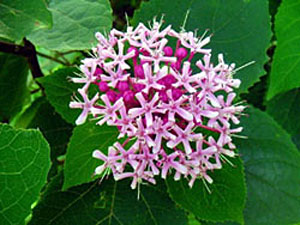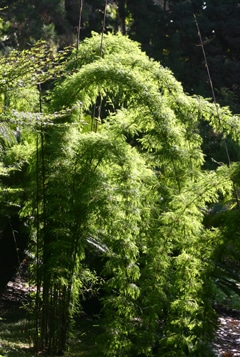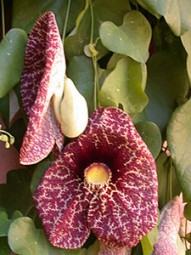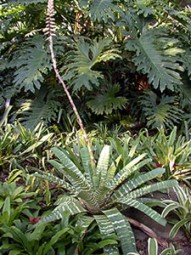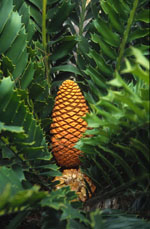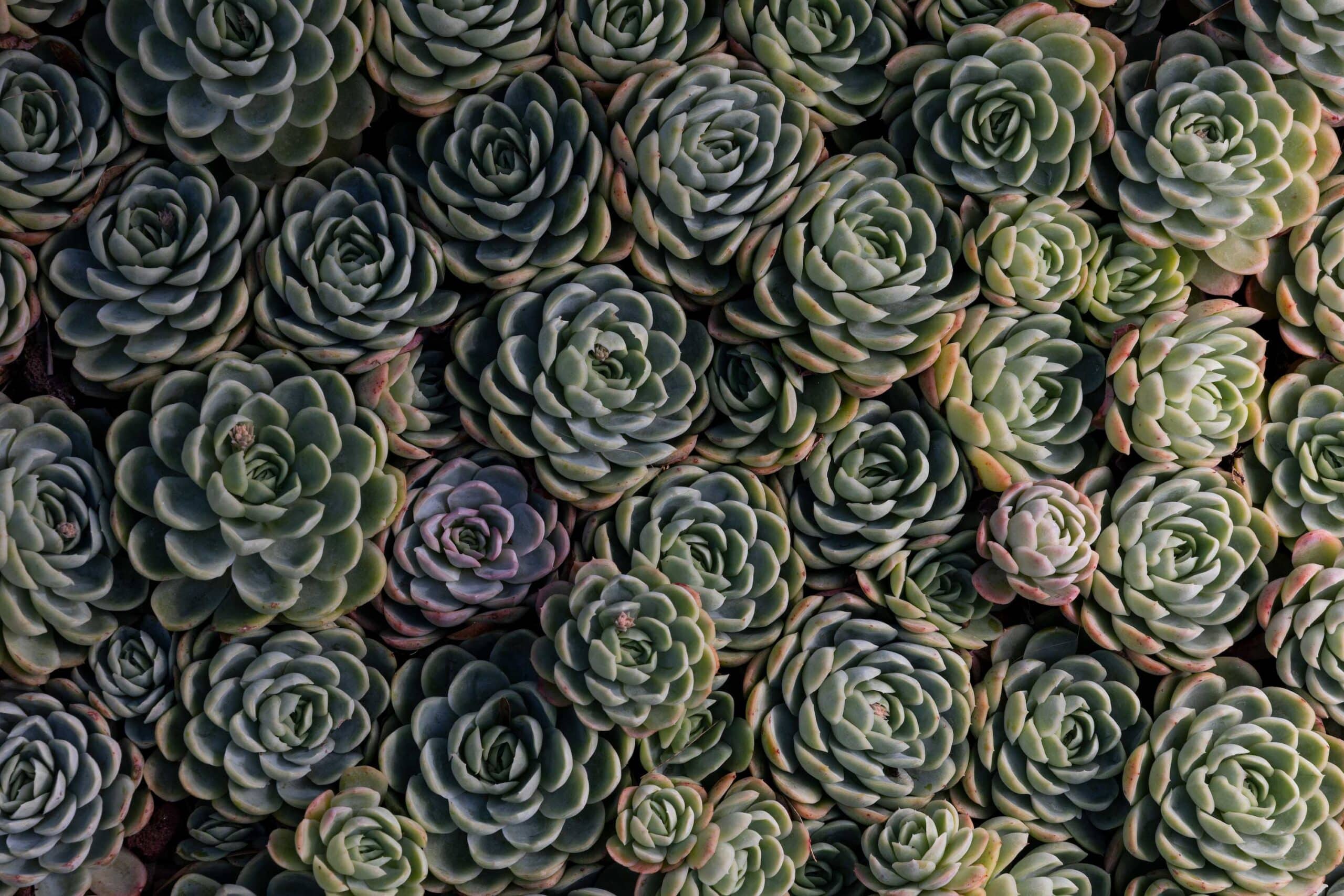
Plant Highlights
Plant Highlights
-
Clerodendrum bungei
cashmere bouquet
Highlight Month:
October
Nativity:
China to Vietnam and Taiwan
Growth Habit:
A shrub up to 6 feet tall. It spreads quickly by underground runners, and can cover a wide area if new sprouts are not pulled up. It is deciduous, and the stems can be cut to the ground after the leaves drop.
Growing Requirements:
Full to partial shade
Features:
Clusters of very fragrant rosy red/purple flowers from mid summer to fall. The leaves are dark green, sometimes veined in purple.
Where at Lotusland:
There is a large planting of C. bungei in the Fern Garden, behind the wall alongside the pool.
-
Chusquea coronalis
fountain bamboo
Highlight Month:
September
Nativity:
Mexico (Chiapas) to Central America
Growth Habit:
The stems of this bamboo grow in a tight clump. They shoot straight up for 15 feet or so and as the leaves open, the whole culm will arch down toward the ground. Where it touches the ground, an individual stem can form roots and thus a new plant. Leaves occur in whorls along the stems.
Growing Requirements:
This species will grow in sun or partial shade with moderate water. It is hardy only to about 28 degrees and does not do well with extreme heat.
Features:
The fluffy appearance of the leaves and graceful arching culms make this plant highly ornamental
Where at Lotusland:
Japanese Garden
-
Aristolochia gigantea x littoralis
hybrid dutchman’s pipe
Highlight Month:
August
Nativity:
Garden Origin
Growth Habit:
A rapidly-growing woody vine with heart-shaped leaves.
Growing Requirements:
Grows best in full sun to partial shade, with regular watering. This rapidly growing vine can reach lengths of 15-20 feet with a structure to climb on.
Features:
Dramatic burgundy flowers with yellow centers bloom summer through fall and resemble an inflated balloon before opening. Flies are attracted to the scent of the flower, become temporarily trapped inside by downward pointing hairs, and are later released once they are covered in pollen.
Where at Lotusland:
Pavilion Patio
-
Vriesea fosteriana
Highlight Month:
October
Nativity:
Southern Brazil
Growth Habit:
A perennial forming a loose rosette. The leaves can reach up to 3 feet long and the flower spike grows over 5 feet tall. The flowers bloom at night and are pollinated by bats in habitat.
Growing Requirements:
For best color V. fosteriana should be grown with filtered light but not in direct sun. The plant grows best in a well-drained soil as it is shallow-rooted and may rot in wet soils. It also obtains moisture collected in the “cup” in the center of the leaves.
Features:
This bromeliad is grown for its impressive foliage which has striking wavy patterns on a dark green background. The pale yellow bell-shaped flowers are arranged in rows on a spike that emerges from the center of the plant. There are several varieties and cultivars including ‘Red Chestnut’ which has the same striking markings but with dark red coloring.
Where at Lotusland:
There are several V. fosteriana and clumps of ‘Red Chestnut’ in the Upper and Lower Bromeliad Gardens.
-
Encephalartos ferox
Tongaland cycad
Highlight Month:
October
Nativity:
South Africa, Mozambique
Growth Habit:
This cycad is typical of many African species of Encephalartos. It has a rosette of very tough and spine-tipped leaves that arise from a large stem. The stems may be one and a half feet in diameter. This species grows in coastal areas in grass and other scrub vegetation from KwaZulu Natal north to Mozambique. It often occurs within 50 yards of the beach.
Growing Requirements:
E. ferox does best with full sun and regular water. It must have excellent drainage to prevent fungal problems in our cold, wet winters. Cycads are slow-growing.
Features:
The brightly colored red cones of E. ferox as well as the glossy green foliage make this a very handsome garden specimen.
Where at Lotusland:
Cycad Garden
-
Metasequoia glyptostroboides
dawn redwood
Highlight Month:
October
Nativity:
Sichuan, China
Growth Habit:
Dawn redwood has a conical shape that resembles the coast redwood, Sequoia sempervirens, to which it is related. The cones are distinctive and the dawn redwood is deciduous in winter rather than evergreen. It is the only species in its genus, but was originally described in 1941 from fossilized remnants with living material only noted in 1948. While initially fast growing, it only attains its ultimate height of 200 feet after many years.
Growing Requirements:
Metasequoia is quite frost tolerant; down to minus 10° F. It requires regular water, but grows in most soils.
Features:
In spring, the bright green foliage emerges and in fall, the entire tree becomes clothed in shades of rust before the leaves are shed.
Where at Lotusland:
Insectary Garden
-
Euphorbia ammak ‘Variegata’
ghost euphorbia
Highlight Month:
October
Nativity:
Arabian Peninsula
Growth Habit:
Euphorbia ammak is also known as the African candelabra euphorbia (in spite of not growing on the African mainland), which accurately describes its growth as a central trunk with multiple branches. It can attain heights of 30 feet in its natural habitat.
Growing Requirements:
As with all succulent Euphorbia, the ghost euphorbia requires well-drained soil and full sun. This variegated form can tolerate some shade. Minimal water needs make it suitable for drier climates, but it can be successfully grown in a pot and protected from rain in wetter areas.
Features:
The variegation in this form is extreme, giving the whole plant a ghostly pallor.
Where at Lotusland:
Main Drive
-
Begonia ‘Freddie’
Highlight Month:
October
Nativity:
Garden Origin
Growth Habit:
This begonia has large (about 1 inch diameter) creeping rhizomes. Large leaves arise along the length of the rhizome on long hairy petioles. Small, bright pink flowers are held in airy clusters above the foliage.
Growing Requirements:
Most begonias grow best in dappled shade or half sun and require even moisture. Brief exposure to light frost may burn the foliage. Freezing temperatures will kill the plant.
Features:
The large (up to 2 feet or more in diameter) leaves are glossy green on top and burgundy red underneath. This cultivar is a hybrid created by the famed Rudy Ziesenhenne by crossing Begonia manicata ‘Aureo-maculata’ with B. barkeri, and was named for one of his sons.
Where at Lotusland:
Fern Garden
-
Quercus agrifolia
coast live oak
Highlight Month:
October
Nativity:
W. California to Mexico (N. Baja California)
Growth Habit:
Coast live oaks may grow to 50 or 60 feet, with a wide-spreading canopy many times that in great age. It is evergreen, dropping some of its old leaves in the dry period and growing new ones in the rainy season.
Growing Requirements:
This species is widely adapted; growing from the edge of riparian regions to grassy savannahs. It needs no supplemental irrigation, but can tolerate water in summer if given excellent drainage.
Features:
Oaks provide a multitude of resources to insects, birds and mammals. This month, the acorns are dropping; a major source of food for numerous insects, birds such as scrub jays and acorn woodpeckers as well as squirrels and other rodents.
Where at Lotusland:
Scattered throughout the garden, the oaks are a remnant of the native vegetation of the site. Lotusland staff protect and encourage seedlings that germinate in appropriate sites to preserve this resource.
-
Zamia furfuracea
Cardboard Palm
Highlight Month:
November
Nativity:
Veracruz, Mexico
Growth Habit:
Forms a rosette of leaves 3-4 foot long tightly overlapping leaves.
Growing Requirements:
An easy to grow, adaptable cycad. Plant in well-drained soil with full sun to partial shade. Water when dry; drought-tolerant once established.
Features:
The light green soft new leaves are very attractive, especially in contrast to the darker green mature foliage which has a stiff “cardboard” texture. Z. furfuracea makes a striking accent plant in the landscape, or an attractive container plant either indoors or on a patio.
Where at Lotusland:
Lotusland’s Zamia furfuracea are planted in the Cycad Garden along with several other Zamia species.


